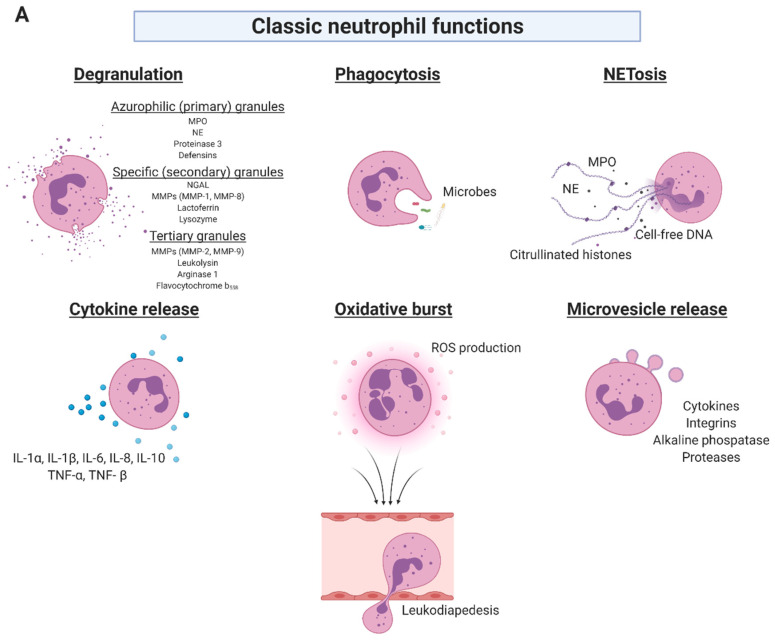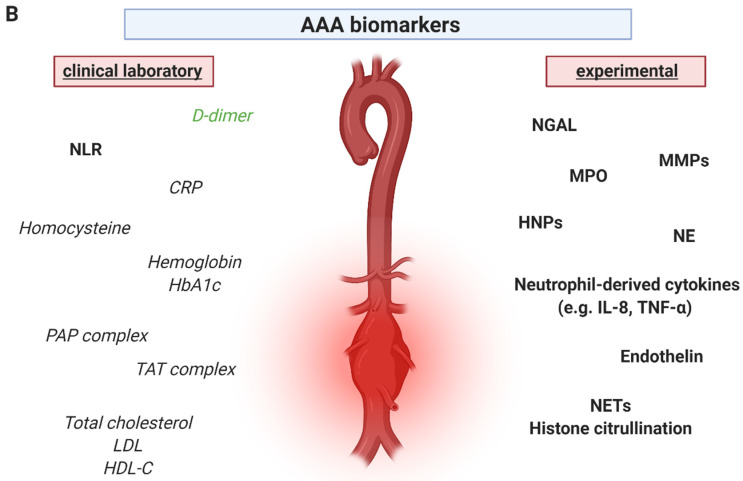Figure 1.
Overview of classical neutrophil functions as well as investigated AAA biomarkers. (A) Neutrophils are polymorphonuclear leukocytes that serve as the initial line of defense against invading pathogens and moreover play a key role in a variety of inflammatory conditions and cardiovascular diseases such as AAA. These granulocytes exert several classical functions, which can act as a double-edged sword of neutrophil antimicrobial function, but excessive activation can damage host tissue. Upon cell activation, several soluble neutrophil granule proteins are released. Phagocytosis and release of neutrophil extracellular traps are evolutionary conserved mechanisms of the unspecific immune defense, however, besides the desired antimicrobial functions, they may also contribute to the acute or chronic pathogenesis of vascular diseases. The production of cytokines by activated neutrophils is striking in its diversity. Neutrophils synthesize and release a variety of pro- and anti-inflammatory cytokines as well as growth factors. Additionally, neutrophils interact with surrounding immune cells and humoral factors leading to modification of cell recruitment and signal cascades via cytokine and microvesicle release. Triggered neutrophils activate their NADPH oxidase to generate substantial amounts of superoxide and other reactive oxygen species, which play a vital role in the progression of cardiovascular diseases. (B) In performing their functions, neutrophils provide a multitude of potential biomarkers, which can be used to improve the diagnosis and prognosis of AAA as well as postoperative outcome. To facilitate data presentation, this overview shows clinically available and experimental biomarkers, which have been investigated, but are currently not used in clinical practice. This selection presents neutrophil-derived biomarkers indicated in bold, clinical biomarkers in italics and specifically the most commonly applied clinical biomarker D-dimer in green. MPO: myeloperoxidase; NE: neutrophil elastase; NGAL: neutrophil gelatinase-associated lipocalin; MMP: matrix metalloproteinase; IL: interleukin; TNF-α: tumor necrosis factor-α; ROS: reactive oxygen species; AAA: abdominal aortic aneurysm; NLR: neutrophil-to-lymphocyte ratio; CRP: C-reactive protein; HbA1c: hemoglobin A1c; PAP: plasmin-alpha-2-antiplasmin; TAT: thrombin–antithrombin; LDL: low-density lipoprotein.; HDL: high-density lipoprotein; HNP: human neutrophil peptide; NET: neutrophil extracellular trap. Figure 1 was created by author J.K. with BioRender.com, last accessed on 8 August 2021.


